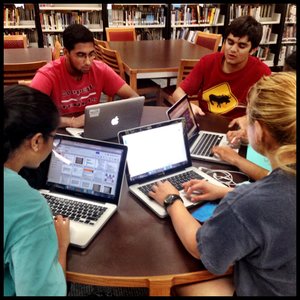Twenty-five years ago, I was a young history teacher soaking up progressive teaching methods that aimed to foster deep, personalized learning for my students. My classroom was decidedly low-tech, but I can see how today’s technological advances might have made it easier for me to manage the significant demands of progressive teaching. Yet in the personalized learning (PL) schools we’ve visited so far for this project, few teachers appear to be taking advantage of technology’s potential to support progressive teaching.

In the late 1990s, I was part of Brown University’s Undergraduate Teacher Education Program (UTEP). UTEP allowed me to graduate with my BA in American History and a secondary teaching credential. Ted Sizer, the chair of Brown’s education department at the time, heavily influenced the program’s curriculum; his belief in the power of coherent, mastery-based, and personalized schools has guided my sense of what schools and teaching should be like ever since.
As a student teacher in Providence, Rhode Island, I spent untold hours earnestly crafting history lessons around “big ideas,” developing case-based learning activities, and learning how to facilitate group work. I asked my students (my “historians”) to work with primary documents and make what today’s Common Core advocates would call evidence-based claims. With these and other progressive approaches, my fellow teacher candidates and I were pushing students toward deeper and individualized learning, though we didn’t use those terms. Teaching this way was incredibly exciting, but it was also extraordinarily time-consuming and challenging.
I wonder if this approach to teaching would have been more doable if I had access to today’s technologies. What if my students and I had been able to use co-writing tools like Google Docs to give each other real-time feedback on their essays? Would my student historians have been more engaged if I could have offered them materials to explore that went beyond the photocopies of diaries, photographs, maps, and speeches that I tracked down from books? Would my students’ presentations have been more powerful if they could have accessed today’s media tools and engaged audiences beyond our classroom? Could today’s technology have helped me and my cohort of teacher trainees more easily share the materials that we spent so much time developing?
There are good reasons to believe the answers to these questions are “yes.” A recent comprehensive review by Barry Fishman and Chris Dede on technology and teaching in the latest edition of AERA’s Handbook of Research on Teaching, for example, describes how the collaborative editing and comment functions in Web 2.0 tools (like Google Docs or wikis) help spread knowledge across students and teachers and help students work together and engage in new ways. This same review describes how more elaborate technologies can help students learn complex topics via simulations and other interactive environments. It doesn’t take much to imagine how the technology we often take for granted in our daily personal lives could support progressive teaching and personalized learning: by enabling communication and collaboration among students and teachers, increasing student choice and differentiation, offering a wider range of when and where students learn, and giving teachers insight into student learning in ways that weren’t possible even a few years ago.
And yet, in the early months of this project, we’re finding that most of the PL schools we visit are taking a decidedly low-tech approach to personalization—sometimes the classrooms we visit don’t look that different from my classroom from a quarter century ago. Some teachers in PL schools told us their schools didn’t have enough money to buy hardware and software tools. Others faced systems barriers, like district-blocked websites (most commonly YouTube), unsupported platforms, or a mix of programs and platforms that didn’t talk to each other. Still others were simply skeptical about technology, didn’t know where to start, or had other priorities, like building a strong school culture.
To be sure, I don’t believe that technology is the be-all and end-all for PL. But as Harvard University’s Chris Dede writes, “… it is hard to imagine how our schools will scale up such [progressive] instruction without support from digital tools and media.” PL schools interested in supporting personalization through progressive teaching should ask themselves how they could use technology to support deeper, meaningful learning in ways that go beyond using tech for drill-and-skill learning. Technology entrepreneurs and university-based experts should develop tech products that engage teachers and students in rich and integrated learning experiences (like Berkley’s Web-Based Science Environment). Schools of education should be asking how they can better prepare teachers to leverage technology for personalization and deeper learning. Progressive teaching ideals have been around for a long time. Maybe today’s technology can finally make this rewarding but demanding approach more doable for teachers and students in more classrooms.
— Michael DeArmond
Michael DeArmond is senior research analyst at the Center on Reinventing Public Education. This post originally appeared on The Lens. It is the second in the CRPE series of “Notes From the Field” on personalized learning.


